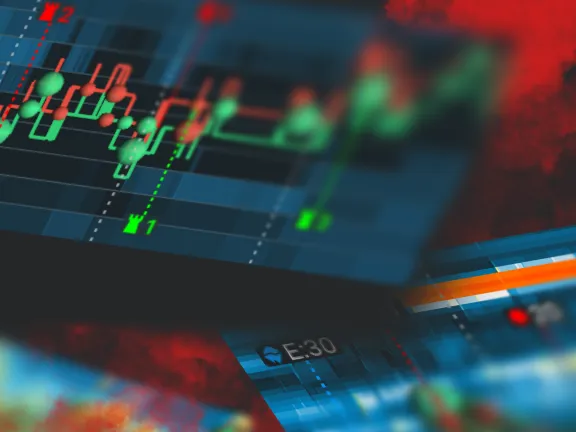

December Trading
Deals Are Live!
Save on Global+, data access,
and add-ons.
See All December Deals

Black Friday
Nov 28-Dec 31
2 days : 8 hours
50% OFF Global+ Quarterly
+ 50% OFF Data (3 months)

Cyber Monday
Dec 1 - Dec 31
2 days : 8 hours
60% OFF Global+ Monthly
+ Data (1 month)

Add-on Deals
Dec 1 - Dec 31
2 days : 8 hours
50% OFF
Add-ons

New Year Sale
Dec 26 - Jan 1
3 days : 8 hours
30% OFF Global+ Lifetime
*Data not included
Education
September 21, 2024
SHARE
Trading Mistakes 101: Common Pitfalls and Finding Solutions

Trading strategies and in-depth market analyses are undeniably crucial. However, it’s often the emotions and psychological factors that distinguish successful traders from the rest. In the ever-evolving landscape of financial markets, not just expertise and skill, but also a deep understanding of these psychological nuances make a significant difference.
Picture the exhilaration during a winning streak, the paralyzing fear amidst a market downturn, the allure of chasing profits, and the sting of unexpected losses.
This article delves into a comprehensive analysis of the complex psychology involved in trading. We will explore the impact of emotions on trading decisions, including:
-
How fear and greed can lead us astray.
-
Why confirmation bias can prove harmful.
-
How overtrading can quietly erode our profits.
-
The role of market analysis tools, such as Bookmap, in assisting traders.
Let’s dive in.
Psychological Factors In Trading Failures
Trading is more than just analyzing charts and data; it encompasses a spectrum of psychological factors that can lead to significant missteps. Recognizing these elements is crucial for traders aiming to optimize their decisions and improve their success rate.
The Role Of Emotions In Trading
Emotions play a significant role in trading and can lead traders astray in several ways, with fear and greed being the most prevalent emotions that can cloud a trader’s judgment.
|
Impact of Fear |
Impact of Greed |
|
|
Let’s understand the impact of emotions in trading:
-
-
Impulsive Decision Making:
-
Successful trading requires a comprehensive trading plan that outlines entry and exit strategies, risk management rules, and position sizing.
-
Traders who operate without a plan are more likely to make impulsive decisions based on their emotions.
-
-
-
Erratic Trade Management:
-
Emotional trading leads to erratic trade management.
-
As such, traders do not follow their pre-defined trading plan.
-
Rather, due to fear and greed, they:
-
Move their stop-loss levels, or
-
Take profits prematurely.
-
-
-
-
Overleveraging:
-
Greed drives traders to overleverage their positions.
-
This puts their capital at significant risk and increases the likelihood of account blowouts.
-
This mainly happens because even small market fluctuations can result in substantial losses.
-
-
-
Improper Money Management:
-
Emotional traders often neglect proper money management techniques.
-
They may risk too much of their capital on a single trade or fail to diversify their portfolio, leaving them vulnerable to substantial losses.
-
Overcoming Confirmation Bias
Confirmation bias represents a tendency to prioritize information that corroborates one’s existing beliefs while discounting or ignoring contrary data. In trading, this bias can be quite harmful:
|
Negative Effects |
Impact on Trader’s Behavior |
Result |
|
Selective Information Gathering |
Traders only seek out news or analysis that aligns with their current positions or biases. |
This leads to a distorted view of the market and promotes poor decision-making. |
|
Ignoring Warning Signs |
Traders ignore warning signs or indicators that suggest a change in market conditions. |
This results in more missed opportunities to:
|
|
Stubbornness |
Traders often cling to losing trades for extended periods, hoping that the market will eventually align with their beliefs.
|
This reluctance to admit mistakes leads to significant losses. |
How to Overcome Confirmation Bias
Traders must take the following actions to mitigate the impact of confirmation bias in trading:
-
Actively seek out diverse sources of information
-
Consider opposing viewpoints
-
Remain open to changing trading strategies based on unbiased analysis
-
Ignore emotional attachments to existing beliefs
-
Develop trading discipline and self-awareness
The Importance Of Risk Management

Without effective risk management, even the most skilled traders can quickly find themselves facing extensive losses. Utilization of stop-loss and take-profit points plays a significant role in safeguarding traders’ capital and managing risk. Let’s understand them in detail.
Utilizing Stop-Loss And Take-Profit Points Effectively
By setting stop-loss and take-profit points, traders can calculate their risk-reward ratio for each trade. This ratio helps them assess whether a trade is worth taking and whether the potential reward justifies the risk. There are several other benefits of using these techniques, which are:
|
Techniques |
Meaning |
Benefits |
|
Stop-Loss Orders |
A stop-loss order is a predetermined price level at which a trader decides to exit a position to limit potential losses.
|
|
|
||
|
||
|
Take-Profit Orders |
A take-profit order is a predefined price level at which a trader decides to exit a position to secure profits. |
|
|
The Pitfalls Of Overtrading
Overtrading refers to a situation where a trader engages in excessive buying and selling of financial assets, often beyond their available capital or risk tolerance. An unusually high number of trades, often with larger positions, are executed.
Overtrading leads to a variety of negative consequences, including:
-
Increased transaction costs
-
Higher levels of stress
-
Emotional burnout, and
-
Significant financial losses.
To prevent overtrading, it is necessary for the traders to recognize the signs of overtrading and practice discipline.
Recognizing The Signs Of Overtrading
There are several signals or symptoms of overtrading that traders should be aware of:
|
The Sign |
The Meaning |
How to Recognize it |
|
High Turnover |
Rapid buying and selling of assets in a short time frame. |
You notice an increased number of trades in your trading history within a relatively short time span.
|
|
Increased Transaction Costs |
With an increase in the number of trades, transaction costs also increase.
|
You observe a significant increase in your transaction costs without a proportional increase in profits. |
|
Frequent Monitoring |
Repeatedly checking the status of:
|
You feel the need to constantly check your positions and act every time there’s a minor market movement. |
|
Diminishing Returns |
Lack of quality trades and only engaging in excessive and unproductive trading.
|
Your profit remains stagnant or even decreases, despite increased trading activity. |
|
Deviation from Strategy |
Lack of trading discipline, taking impulsive decisions, and non-adherence to tested strategies. |
You make trades that don’t align with your predefined trading strategy. |
|
Chasing Losses |
A series of losses is experienced. Afterwards, instead of following a developed trading plan or strategy, impulsive trades are executed. |
The trader is trying to recover losses by hastily entering new trades without proper analysis. |
|
Inadequate Capital Reserves |
Major reduction in the capital reserves, availability of limited funds, and inability to participate in new opportunities. |
Using too much of your trading capital, leaving little reserves for future positions or to manage unexpected market downturns.
|
|
FOMO (Fear of Missing Out): |
Fear of missing out on potential profitable opportunities. |
You are afraid of missing out on potential profitable opportunities and are indulging in prompt, impulsive trades without proper analysis. |
|
Revenge Trading |
Emotionally driven trading occurs when frustration, anger, or a desire for vengeance after suffering losses, prompts engaging in impulsive and emotionally driven trades. |
You react to losses with a sense of anger or frustration, attempting to recover losses quickly, disregarding your tested trading strategy. |
Inadequate Preparation: A Common Misstep In Trading

Traders often overlook the need for thorough preparation, leading to potential losses. With markets continuously evolving due to economic, geopolitical, and technological factors, adapting and staying informed is paramount to trading success.
Staying Updated In Ever-Changing Markets
Financial markets are in a constant state of flux, influenced by a myriad of factors, including:
-
Economic events
-
Geopolitical developments, and
-
Market sentiments
To succeed in this environment, traders must perform the following:
-
Understand and adapt to changing market dynamics, as a trading strategy that worked yesterday might not be effective today.
-
Gain knowledge of technological innovations, such as high-frequency trading, algorithmic trading, and new trading platforms, as they alter market behavior and impact trading strategies.
-
Stay informed about regulatory developments.
-
Monitor and react to geopolitical events, such as elections, trade agreements, and natural disasters.
Bookmap’s Role in Market Monitoring
In the context of staying updated, tools like Bookmap offer a valuable resource for traders. Bookmap provides a continuous stream of market data that ensures traders are always aware of the latest market movements.
Here’s how Bookmap helps traders:
|
Real-Time Data |
Market Transparency |
Risk Management |
|
|
|
The Role Of Strategy Testing
Testing a trading strategy serves several crucial purposes:
-
It confirms the viability of the strategy.
-
It assesses its real-world performance.
-
It enables refinement for practical trading.
The two most common methods for strategy testing are back-testing and paper trading. Traders can use tools like Bookmap to perform these tests effectively.
Importance Of Strategy Testing:
Using Bookmap For Strategy Testing:
Bookmap offers a valuable platform for traders to test and refine their strategies through its simulator mode. This powerful mode allows users to analyze real-time and historical market data without risking capital.
Here’s how Bookmap can be used for strategy testing:
|
The Benefits |
The Explanation |
|
Back-testing |
|
|
Real-time Analysis |
|
|
Order Flow Insights |
|
|
Risk Management Testing |
|
|
Strategy Iteration |
|
Ultimately, consistent strategy testing serves as a trader’s compass in the complex financial markets, helping to navigate potential pitfalls and ensuring that decisions are rooted in both knowledge and experience.
Conclusion
Continuous education remains at the forefront of any trader’s journey. Whether it’s staying updated with market fluctuations, exploring new trading strategies, or understanding global economic changes, continuous learning is paramount. The market does not stand still, and neither should a trader’s knowledge.
But knowledge alone is not sufficient. It must be coupled with the right tools that enable traders to apply what they’ve learned efficiently. Investing in reliable and intuitive tools can make the difference between a successful trade and a missed opportunity.
In conclusion, while the path to trading success is riddled with challenges and uncertainties, with the right blend of self-awareness, dedication to ongoing education, and the right tools, traders can chart a course with increased confidence and assurance. The market’s tides may be ever-shifting, but with preparation and foresight, traders can sail steadily towards their goals.
Ready to elevate your trading game with real-time insights and advanced tools? Dive deeper and explore what Bookmap offers for traders like you. Discover Bookmap today!